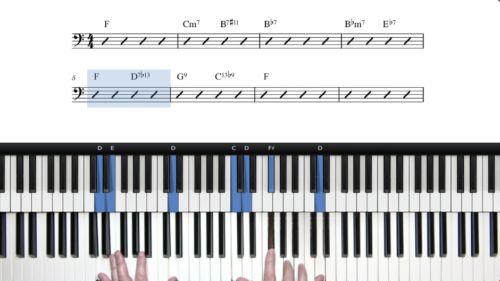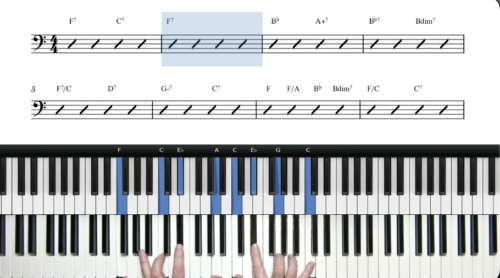Jingle Bells – A Section Improvisation
In this tutorial we explore improvisation over “Jingle Bells” using blues scales, blues licks, and other bluesy melodic ornamentation.
In the harmony module for this tune we added lots of passing chords, reharmonisations, and other harmonic devices. These devices work well for harmonising the original melody, but from an improvisational standpoint my view is that it’s better to simplify the changes.
Similarities with 8 bar blues
The primary chord changes of Jingle Bells share a lot of similarities with the 8 bar blues. We start with the 1 chord, moving to the 4 chord, then to the 5 chord, and finally back to the 1 chord.
We are still going to add additional harmony to the basic 1, 4, and 5 chords, and we will do this in a way that simplifies our options for improvisation.
Techniques & Principles For Improvisation
In this lesson we explore techniques and principles for improvising over the A Section of Jingle Bells. The turnaround licks and lines that we explored in the previous lesson are quite heavy and so it’s nice to lay off a little to start the solo.
- Simple lines outlining G Major Blues Scale
- Include some small intervals and some big intervals
- Include grace notes into the 3rd, and also down to the 2nd
- Outline the moving voice in your improvised melody
- Try to avoid step wise scale passages – also repeat notes
Approaching The Main Chord Changes
When approaching the IV and V chords target the chord tones as strong landing points. We can also add the 25 approach chords in bar 3 and use the C major blues scale to create blues fills and embellishments. We explore some other improvisation principles for the 2nd line:
- Moving to the 2nd line we can play the A-7 as an A9 chord.
- Target the 9 with arpeggios, enclosures, and double octave lines
- Tremolos can be used on both the II and V chords.
Lesson Downloads
-
Jingle Bells Reharmonised File Type: pdf
Practice Tips
-
Practice the left hand accompaniment until you can play it smoothly without mistakes and this will set the strong foundations for right hand improvisation.
-
Let the solo breath. It’s better to play fewer notes and create a nice motif than it is to play many notes with no meaning.
-
For the final 3625, start by targeting a chord tone and also incorporate arpeggios to add some variety to the blues licks. The chromatic lines also work well over the E7.
-
Perhaps repeat this twice for the solo section – or as many times as you like - and then come back to head of the tune.







